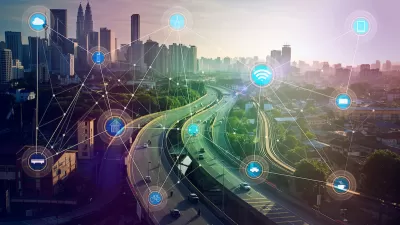It's easy to think of GPS technology as a personal navigation device, but the potential for a faster, cheaper GPS technology extends deep into the emerging Internet of Things.
Aarian Marshall reports on a breakthrough in GPS technology that will improve the performance of GPS for the masses—on their mobile phones, of course.
Marshall begins the article by noting that GPS technology is much more accurate than anyone who only uses a smart phone realizes:
Surveyors have used GPS to measure down to the centimeter for some time now. More precise GPS identifies signals at a higher frequency, called the carrier phase, but must use complex bits of mathematics to figure out locations. The problem is that this process is slow, and speeding it up to make it widely available to the public is expensive.
Enter Ray Farrell, a professor and electrical and computer engineering chair at the Bourns College of Engineering at the University of California, Riverside, who along with some colleagues published a paper in the journal IEEE, which describes a breakthrough in "[combining] GPS measurements with data from an inertial measurement unit, or IMU, which is an electronic device that can measure force and angular velocity."
Marshall describes in additional detail the technological advancement discovered by the team of engineers, but the notable result of their work: "very precise GPS just got a lot faster, and a lot cheaper." Beyond the personal applications possible with the new technology, Farrell and team focus mostly on the Internet of things: specifically the sensors that will be necessary to drive a fleet of automated vehicles.
FULL STORY: Super-Accurate GPS Just Got a Lot Cheaper and Faster

Planetizen Federal Action Tracker
A weekly monitor of how Trump’s orders and actions are impacting planners and planning in America.

San Francisco's School District Spent $105M To Build Affordable Housing for Teachers — And That's Just the Beginning
SFUSD joins a growing list of school districts using their land holdings to address housing affordability challenges faced by their own employees.

The Tiny, Adorable $7,000 Car Turning Japan Onto EVs
The single seat Mibot charges from a regular plug as quickly as an iPad, and is about half the price of an average EV.

With Protected Lanes, 460% More People Commute by Bike
For those needing more ammo, more data proving what we already knew is here.

In More Metros Than You’d Think, Suburbs are Now More Expensive Than the City
If you're moving to the burbs to save on square footage, data shows you should think again.

The States Losing Rural Delivery Rooms at an Alarming Pace
In some states, as few as 9% of rural hospitals still deliver babies. As a result, rising pre-term births, no adequate pre-term care and "harrowing" close calls are a growing reality.
Urban Design for Planners 1: Software Tools
This six-course series explores essential urban design concepts using open source software and equips planners with the tools they need to participate fully in the urban design process.
Planning for Universal Design
Learn the tools for implementing Universal Design in planning regulations.
Smith Gee Studio
City of Charlotte
City of Camden Redevelopment Agency
City of Astoria
Transportation Research & Education Center (TREC) at Portland State University
US High Speed Rail Association
City of Camden Redevelopment Agency
Municipality of Princeton (NJ)





























